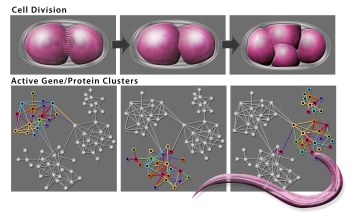News Release 05-135
Worm Studies Give Researchers New Perspective on Embryo Formation
Analysis reveals the molecular machines that drive development
August 10, 2005
This material is available primarily for archival purposes. Telephone numbers or other contact information may be out of date; please see current contact information at media contacts.
How does a multi-cellular organism with specialized organs and tissues develop from a single cell? A team of genomics researchers has moved closer to answering this question by creating the first comprehensive diagram of the molecular interactions that orchestrate early embryo development.
The work--a collaborative effort by scientists from New York University (NYU), Harvard University, the Max Planck Institute and Cenix BioScience in Dresden, Germany--appears in the Aug. 11 issue of the journal Nature.
The team examined the first two cell divisions of Caenorhabditis elegans--a small, transparent, soil-dwelling roundworm widely used as a model organism for studying embryo development and the first animal to have its entire genome sequenced. They used a new approach to combine information from several large-scale, genomics studies on the functions and activity profiles of C. elegans genes and proteins. From their efforts emerged a detailed view of the molecular interaction networks that drive early embryo development.
"The earliest stages of embryo development are important to study because they set up the framework for all subsequent development in that animal," said Kris Gunsalus, NYU researcher and a lead author of the study. By the first cell division, the conditions that influence the worm's specialized tissue and organ development and dictate its body plan have already been established. "The integrated picture we generated in this work provides a 'first draft' molecular map of early embryo development from a global, system-wide perspective."
Their map suggests that a small number of protein groups or clusters--dubbed "molecular machines" by the researchers--coordinates proper embryo development in the worm. The observed "clustering" patterns suggested potential roles for several unstudied genes--information that was not obvious from the original, individual studies. Subsequent experiments confirmed these functions and demonstrated the predictive power of their approach.
C. elegans contains many of the genes and proteins found in more complex organisms--including humans--so these results will help scientists understand more about the universal aspects of development.
The National Science Foundation (NSF) supported two members of the research team, including Gunsalus, who received an NSF ADVANCE Fellows award. The goal of the ADVANCE program is to increase the representation and advancement of women in academic science and engineering careers. "The ADVANCE grant gave me the freedom to develop skills and pursue collaborative projects that moved my professional career forward," said Gunsalus. "For me, the ADVANCE award was a great opportunity to kick-start a new phase of my career."
The National Institutes of Health and the Taplin Funds for Discovery also supported the work. For more information, see the New York University press release.
-NSF-
Media Contacts
Nicole Mahoney, NSF, (703) 292-5321, email: nmahoney@nsf.gov
Program Contacts
Michael L. Mishkind, NSF, (703) 292-7190, email: mmishkin@nsf.gov
Carter Kimsey, NSF, (703) 292-8470, email: ckimsey@nsf.gov
Principal Investigators
Kristin C. Gunsalus, New York University, (212) 998-8236, email: kcg1@nyu.edu
The U.S. National Science Foundation propels the nation forward by advancing fundamental research in all fields of science and engineering. NSF supports research and people by providing facilities, instruments and funding to support their ingenuity and sustain the U.S. as a global leader in research and innovation. With a fiscal year 2023 budget of $9.5 billion, NSF funds reach all 50 states through grants to nearly 2,000 colleges, universities and institutions. Each year, NSF receives more than 40,000 competitive proposals and makes about 11,000 new awards. Those awards include support for cooperative research with industry, Arctic and Antarctic research and operations, and U.S. participation in international scientific efforts.
Connect with us online
NSF website: nsf.gov
NSF News: nsf.gov/news
For News Media: nsf.gov/news/newsroom
Statistics: nsf.gov/statistics/
Awards database: nsf.gov/awardsearch/
Follow us on social
Twitter: twitter.com/NSF
Facebook: facebook.com/US.NSF
Instagram: instagram.com/nsfgov



